2. 西安建筑科技大学西北水资源与环境生态教育部重点实验室, 西安 710055;
3. 黄淮学院建筑工程学院, 驻马店 463000
2. Key Laboratory of Northwest Water Resource, Environment and Ecology, Ministry of Education, Xi'an University of Architecture and Technology, Xi'an 710055, China;
3. School of Architecture and Engineering, Huanghuai University, Zhumadian 463000, China
水源水中溶解性有机物(dissolved organic matter, DOM)是影响饮用水水质安全和水处理工艺运行的重要因素. DOM不但是水中色度和嗅味的重要来源, 还是氯化消毒副产物的主要前体物, 对饮用水的感官性状和化学安全性都有着重要影响[1].此外, 在饮用水输配过程中部分DOM能够作为微生物生长的基质, 影响着饮用水的生物安全性[2].从饮用水处理工艺运行的角度来看, DOM一方面是混凝、吸附、膜过滤等工艺单元的去除对象, 另一方面DOM会影响混凝剂投量, 与微量污染物竞争吸附位, 导致膜污染[3, 4].
水库作为许多城市的主要供水水源, 其水力特征与河流有明显差异.对于深水型水库, 太阳辐射和热量传递的差异会导致水温和密度随水深而变化, 从而形成水体热分层, 从上至下分别是变温层、斜温层和等温层[5].热分层期水体密度差阻碍着上下水体间物质的交换, 底部水体无法得到大气复氧, 在还原性物质和微生物等的耗氧作用下溶解氧会逐渐降低, 进入缺氧甚至厌氧状态, 引起水-沉积物界面处氮、磷、铁、锰、有机物等的形态转化; 与此同时, 在适宜的光照、温度、营养盐等条件下表层水体会出现藻类等浮游植物的大量繁殖, 并存在一定的光化学降解作用; 此外, 入库径流的外源输入对水质也有重要影响[6~8].目前, 关于深水型水库DOM的来源、特征及其迁移转化已有一定的研究, 例如, Chen等[9]对近年来关于沉积物中DOM的研究文献进行了全面综述, 分析了沉积物与上覆水DOM在质量浓度、性质等方面的异同; Zhou等[1]考察了入库流量变化对大型水源水库中发色DOM组成和性质的影响; 黄廷林等[10]利用紫外光谱和三维激发-发射矩阵(excitation-emission matrix, EEM)荧光光谱分析了冬季混合期两个深水型水库DOM的性质, 说明了DOM来源和特征与流域土地利用的关系; 黄廷林等[11]和方开凯等[12]通过光谱分析研究了热分层期库区内不同位置表层DOM的来源和特征.但上述研究主要关注DOM在流域内以及水-沉积物界面的迁移转化过程, 关于DOM特性对水体热分层的响应特征及其影响鲜有报道.
黑河金盆水库总库容2.0亿m3, 有效库容1.77亿m3, 是西安市主要饮用水水源, 该水库为峡谷型深水水库, 主库区平均水深60~95m, 每年7~9月会形成稳定的热分层[13].本研究在监测热分层期水温和溶解氧随水深变化的基础上, 利用紫外吸收光谱和EEM考察变温层、斜温层和等温层DOM特性, 通过平板膜短期实验考察DOM膜污染特征, 以期为分层型水源水库和相应自来水厂的运行调度提供依据.
1 材料与方法 1.1 样品的采集与预处理2016年7~9月在黑河金盆水库引水塔附近使用深水采样器采集变温层(水深0.5 m)、斜温层(水深20 m)和等温层(水深60 m)水样, 水样采集后12 h内带回实验室用0.45 μm玻璃纤维滤膜过滤, 过滤后水样保存在4℃的冰箱内, 3 d内完成所有实验.
1.2 实验仪器与方法使用TOC-L-CPN总有机碳分析仪(日本, 岛津)测定溶解性有机碳(DOC).使用F-3900紫外分光光度计(日本, 日立)和1 cm石英比色皿测定紫外吸光度.采用F-7000荧光光谱仪(日本, 日立)测定EEM光谱, 激发波长范围为200~400 nm, 发射波长范围为250~500 nm, 激发光和发射光狭缝宽度均为5 nm, 扫描速度为12 000 nm·min-1.
DOM是由结构和性质差异很大的许多物质构成的混合物, 因此测得的EEM光谱实际上是不同荧光组分相互叠加的结果.平行因子分析(PARAFAC)作为一种多组分分析数学方法, 能够实现多组分混合体系中组成成分的识别和分离, 将其与EEM结合能够识别DOM中的独立荧光组分, 并对各荧光组分进行定量.本研究采用文献[14]开发的DOMFluor工具箱和Matlab 2012a软件对EEM数据进行PARAFAC分析.
采用平板膜超滤实验考察不同水深处DOM膜污染特性.超滤实验在Amicon 8400超滤杯(美国, 密理博)中进行, 采用蠕动泵抽吸的恒通量运行模式, 使用的膜通量为150 L·(m2·h)-1, 膜过滤实验步骤和膜污染指数的计算见文献[15].
2 结果与讨论 2.1 水库热分层特征黑河金盆水库2016年7~9月水体热分层和溶解氧分层状况如图 1所示.由图 1(a)可以看出, 2016年7~9月表层水体与底层水体存在明显温差, 水库表层水体在强烈的太阳辐射和大气热交换作用下温度较高, 8月中旬表层水体温度最高达到28℃; 随着水深的增加, 太阳辐射迅速衰减且风力混合作用减弱, 水深10~40 m范围内水温迅速下降; 底部水体受太阳辐射和热交换作用影响很小, 水温一直保持在7℃左右. 7~9月上下层水体温度差达15℃以上, 这导致水体密度随水深增大而增加, 水体处于稳定分层状态.

|
图 1 2016年7~9月黑河金盆水库水体热分层和溶解氧分层特征 Fig. 1 Stratification of the water temperature and dissolved oxygen in the Heihe Jinpen Reservoir during July-Sept., 2016 |
由图 1(b)可以看出, 水体热分层期, 由于上下水体间物质交换受到抑制, 溶解氧也处于分层状态.水库表层溶解氧在8 mg·L-1以上, 基本处于饱和状态; 斜温层水体溶解氧基本在6~7 mg·L-1范围内, 低于表层, 但随水深增加无明显降低; 底部等温层水体溶解氧随水深增加逐渐降低, 到9月中旬, 底部溶解氧已降至0 mg·L-1.
2.2 水体分层期DOM质量浓度与性质随水深的变化水体分层期黑河金盆水库不同水深处DOM质量浓度如图 2所示.可以看出, 水体分层期DOM质量浓度也呈现一定的分层性, 斜温层DOC质量浓度在2.69~3.25 mg·L-1范围内变化, 高于同期等温层和变温层的DOC质量浓度.不同水深处DOM质量浓度的差异是外源径流输入、表层水体光化学降解和藻类繁殖、底部沉积-释放等多种过程综合作用的结果.水体分层期入库径流为等密度潜流, 由于研究期间无强降雨发生, 入库径流泥沙浓度很低, 入流密度主要受水温影响, 可以认为是等温度潜流[13, 16]. 2016年7~9月黑河金盆水库入库径流温度在14~21℃范围内变化, 由图 1(a)可知, 按照等温度潜流, 分层期入库径流的主要影响范围是水深15~20 m处, 因此, 斜温层水体DOM质量浓度较高主要是由于径流携带的外源有机物输入造成的.变温层水体DOM质量浓度受光化学降解作用和藻类等浮游植物繁殖影响较大, 太阳辐射造成的光化学降解作用会使部分DOM矿化[17, 18], 这是造成变温层DOM质量浓度低于斜温层和等温层的重要原因; 而同期的藻密度监测结果表明, 8月藻类数量出现了小幅度升高, 8月下旬藻密度达到了521×104个·L-1, 藻类分泌的有机物可能是造成8月变温层DOM质量浓度增加的重要原因[19, 20].等温层水体DOM质量浓度和性质与水-沉积物界面有机物的迁移转化密切相关, 本研究中等温层DOM质量浓度低于斜温层, 且在分层期内有所降低, 未出现沉积物中有机物向上覆水体的释放, 这与黑河金盆水库沉积物较低的污染负荷有关[21].
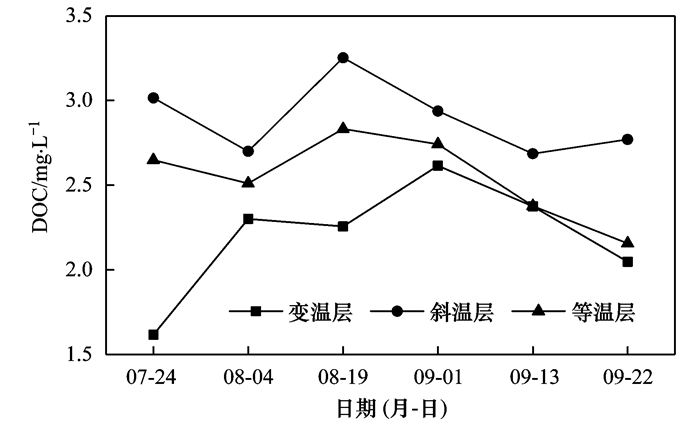
|
图 2 黑河金盆水库热分层期DOM质量浓度的时空变化 Fig. 2 Variation of the DOM concentration in the Heihe Jinpen Reservoir during thermal stratification |
紫外吸光度(UV254)可用于表征含有共轭双键、苯环等不饱和结构的DOM, 比紫外吸光度(SUVA)常用作表征DOM芳香化程度的指标, 有研究表明SUVA与DOM的亲疏水性和分子量大小有一定相关性, 较高的SUVA值说明DOM中疏水性、大分子组分所占比例较高[22]. 图 3为2016年7~9月黑河金盆水库DOM的紫外吸收特征随时间和水深的变化.可以看出, 水体分层期DOM的紫外吸收特性表现出明显的垂向差异, 变温层DOM的UV254最低(0.034~0.063 cm-1), SUVA为1.52~2.71 L·(mg·m)-1, 这与文献[23]报道的光化学降解主要破坏DOM的不饱和结构以及藻源有机物的芳香度较低相符, 进一步说明了变温层DOM主要受光化学降解和藻类繁殖影响; 斜温层DOM的UV254最高(0.074~0.099 cm-1), SUVA为2.29~3.48 L·(mg·m)-1, 明显高于变温层和等温层DOM, 这与斜温层水体受入库径流影响较大有关, 黑河金盆水库上游森林覆盖率较高, 入库径流携带的DOM主要是芳香度较高的腐殖质类, 因此斜温层DOM的芳香度较高[10].
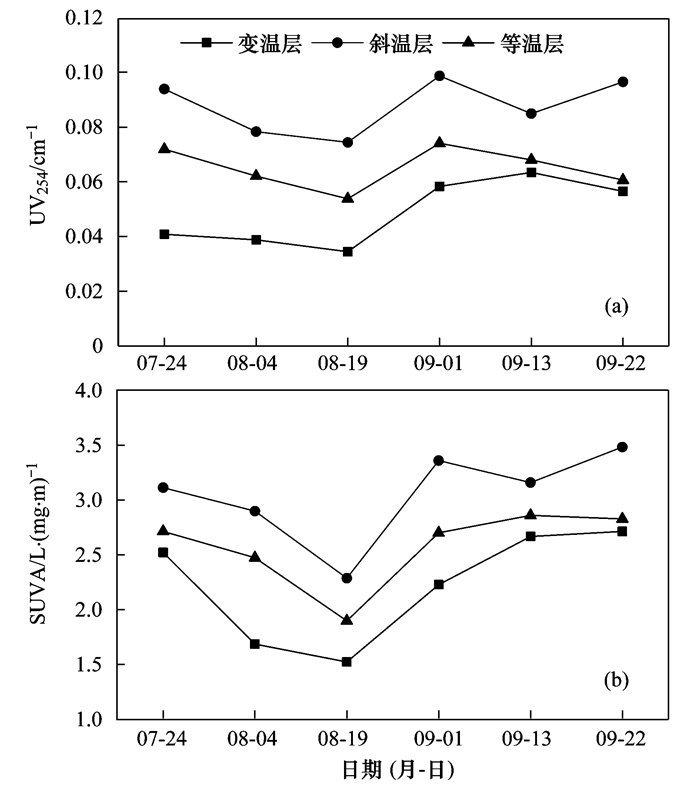
|
图 3 黑河金盆水库热分层期DOM紫外吸收特征的时空变化 Fig. 3 Variation of the DOM's UV absorbance properties in the Heihe Jinpen Reservoir during thermal stratification |
EEM光谱灵敏度高, 测定速度快, 样品预处理简单, 近年来已成为研究水中DOM性质和迁移转化规律的重要手段.本研究对热分层期不同水深处DOM进行了EEM光谱分析, 采用PARAFAC分析得到了3种荧光组分(图 4), 结合已有报道[24, 25], C1组分为类富里酸有机物, C2组分为类腐殖酸有机物, C3组分为类色氨酸有机物.不同荧光组分的来源和特性有较大差异, C1和C2组分的主要来源为陆源腐殖质, 与C2组分相比, C1组分分子量较小, 疏水性较弱[26]; C3组分主要是内源有机物, 一般与藻类、细菌等微生物活动密切相关[14].
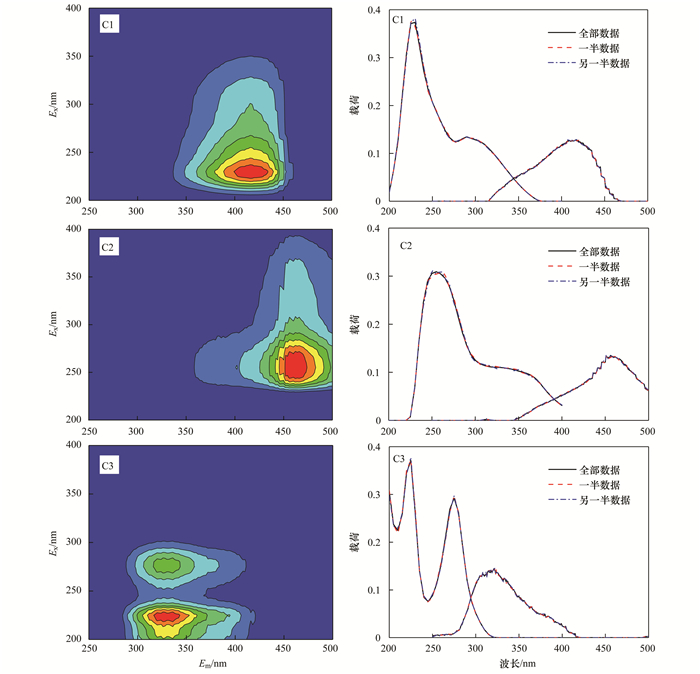
|
图 4 平行因子分析法解析出的3种荧光组分 Fig. 4 Three fluorescence components identified by the PARAFAC analysis |
各组分荧光强度随时间和水深的变化如图 5所示.可以看出, 变温层中C1和C2组分荧光强度较低, 说明变温层中的光化学降解作用对腐殖质类的降解作用较强, 这与腐殖质类物质对紫外线较强的吸收能力有关.斜温层中C1和C2组分荧光强度高于等温层, 进一步说明入库径流携带的外源腐殖质对斜温层的影响大于对底部等温层的影响. C3组分与藻源有机物密切相关, 7月22日变温层中C3组分荧光强度略高于斜温层和等温层, 8月4日随着表层藻类繁殖增强, 变温层中C3组分荧光强度由7月22日的0.23 R.U.增加至0.49 R.U., 而斜温层和等温层中C3组分仅略有升高, 说明表层水中的藻类繁殖尚未影响到斜温层和等温层; 8月19日变温层中C3组分略有下降, 而斜温层和等温层中该组分荧光强度有一定增加, 这应该是由于部分衰亡藻细胞沉降以及藻源有机物扩散进入斜温层和等温层水体; 之后各层C3组分荧光强度均不断降低, 这与C3组分易被生物作用降解有关[27].
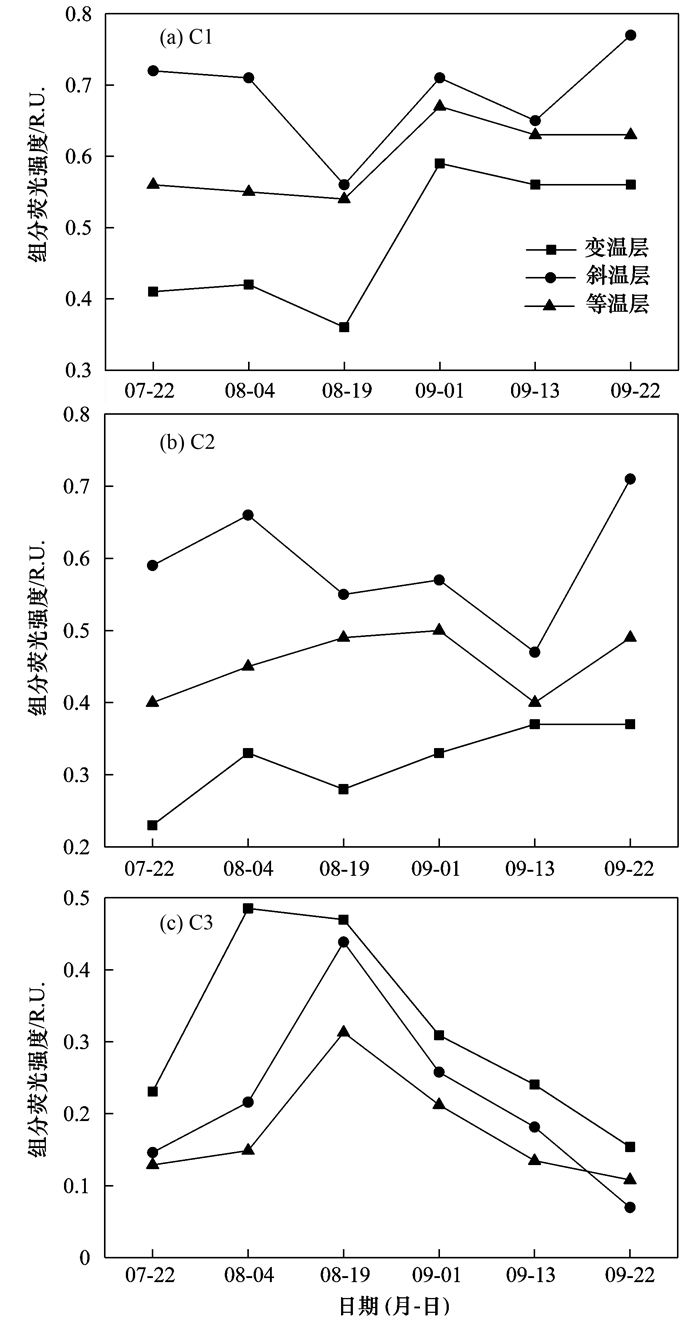
|
图 5 黑河金盆水库热分层期3种组分荧光强度的时空变化 Fig. 5 Variation of the fluorescence intensity of the three components in the Heihe Jinpen Reservoir during thermal stratification |
超滤膜对包括病毒在内的病原微生物具有优异的去除能力, 随着超滤膜技术的发展和膜成本的降低, 超滤膜在自来水厂中的应用逐渐增加, 而DOM造成的膜污染是影响超滤工艺推广应用的主要障碍[28].为了探明水体分层期DOM质量浓度和性质的分层特征对膜污染的影响, 使用9月1日采集的水样评价了不同水深处DOM的膜污染特征, 结果如图 6所示.由总污染指数可以看出, 变温层DOM造成的膜污染最严重, 总污染指数为(3.42±0.71)m-1, 明显高于斜温层和等温层DOM造成的膜污染; 但水力反洗后剩余的不可逆污染方面, 变温层DOM造成的不可逆污染指数略低于斜温层和等温层DOM, 这说明变温层DOM导致的膜污染的可逆性较好.
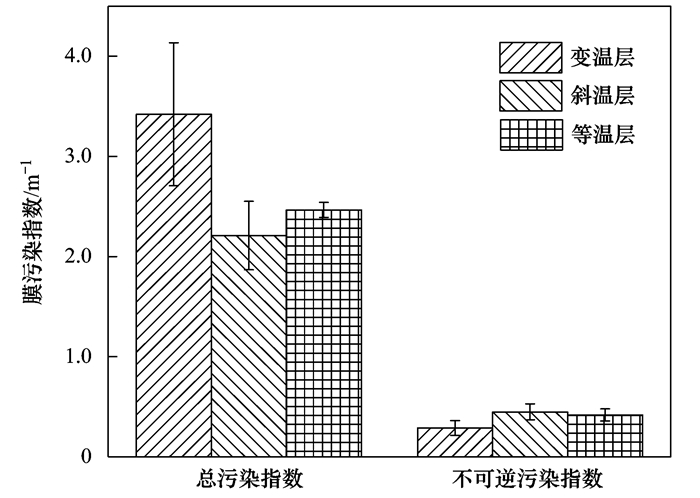
|
图 6 黑河金盆水库热分层期DOM膜污染特性 Fig. 6 Fouling potential of DOM in the Heihe Jinpen Reservoir during thermal stratification |
为了探究DOM组成对膜污染的影响, 利用EEM-PARAFAC分析得到原水、膜出水、浓缩液、反洗水中各组分的荧光强度, 分析了超滤过程中各荧光组分的迁移规律, 其中膜上沉积是通过物质平衡得到的反冲洗后仍残留在膜上的部分[29], 结果如图 7所示.可以看出, 不同水层DOM各荧光组分的迁移规律基本一致.对于C1和C2组分, 膜出水中所占比例为66%~73%, 浓缩液中所占比例为11%~13%, 反洗水中所占比例为3%~6%, 膜上沉积所占比例为10%~18%;对于C3组分, 膜出水中所占比例为53%~59%, 浓缩液中所占比例为8%~10%, 反洗水中所占比例为27%~30%, 膜上沉积所占比例为5%~9%.可以看出, 超滤膜对各组分的截留率均高于对DOM整体的截留率, 说明荧光类DOM在膜污染中起着重要作用; 超滤膜对C3组分的截留率高于C1和C2组分, 说明C3组分可能对膜污染有较大影响, 这与C3组分中分子量较大的蛋白质等生物大分子有关; 在反洗水中所占比例方面, C3组分明显高于C1和C2组分, 这说明被膜截留的C3组分易于反洗去除, 而被截留的C1和C2组分很难被水力反洗去除, 这可能是由腐殖质类物质较强的疏水性造成的; 在膜上沉积所占比例方面, 水力反洗之后各荧光组分均有一部分沉积在膜上, 说明各荧光组分均造成了不可逆污染, 相比而言, C1和C2组分反洗之后沉积在膜上的比例高于C3组分.

|
图 7 各荧光组分在超滤过程中的迁移 Fig. 7 Migration of the three fluorescence components during ultrafiltration |
超滤过程中各荧光组分的迁移规律表明, C3组分被膜截留的比例较大, 对总污染影响大, 但污染的可逆性较好; C1和C2组分被膜截留的比例小于C3组分, 但被截留后难以被反冲洗去除, 对不可逆污染有重要影响.由于变温层中C3组分荧光强度较高, 因此变温层DOM造成的总污染最高, 但污染的可逆性较好, 不可逆污染反而略低于斜温层和等温层.
3 结论(1) 黑河金盆水库夏秋季形成稳定的热分层, 热分层抑制了水体垂向的物质迁移扩散, 使DOM的质量浓度和性质也呈现出一定的分层特征.
(2) 变温层DOM受光化学降解作用影响较大, 其质量浓度低于中下部水体, 同时受藻类等浮游植物产生的有机物的影响, 芳香度较低, 类富里酸(C1)和类腐殖酸(C2)组分荧光强度较低, 而类色氨酸(C3)组分荧光强度较高.
(3) 在等密度潜流的作用下, 斜温层水体受入库径流影响较大, DOM质量浓度高于变温层和等温层, 且呈现明显的陆源输入特征, 芳香度较高, C1和C2组分荧光强度较高, C3组分荧光强度较低.
(4) 与C1和C2组分相比, C3组分被超滤膜截留比例较高, 但被截留的C3组分易被反洗去除, 可逆性较好.因此, 虽然变温层DOM质量浓度最低, 但由于C3组分荧光强度较高, 造成的总污染大于斜温层和等温层, 而不可逆污染小于斜温层和等温层.
| [1] | Zhou Y Q, Zhang Y L, Jeppesen E, et al. Inflow rate-driven changes in the composition and dynamics of chromophoric dissolved organic matter in a large drinking water lake[J]. Water Research, 2016, 100: 211-221. DOI:10.1016/j.watres.2016.05.021 |
| [2] | Escobar I C, Randall A A, Taylor J S. Bacterial growth in distribution systems:effect of assimilable organic carbon and biodegradable dissolved organic carbon[J]. Environmental Science & Technology, 2001, 35(17): 3442-3447. |
| [3] | Raeke J, Lechtenfeld O J, Tittel J, et al. Linking the mobilization of dissolved organic matter in catchments and its removal in drinking water treatment to its molecular characteristics[J]. Water Research, 2017, 113: 149-159. DOI:10.1016/j.watres.2017.01.066 |
| [4] | Aschermann G, Jeihanipour A, Shen J J, et al. Seasonal variation of organic matter concentration and characteristics in the Maji ya Chai River (Tanzania):impact on treatability by ultrafiltration[J]. Water Research, 2016, 101: 370-381. DOI:10.1016/j.watres.2016.05.022 |
| [5] |
王敬富, 陈敬安, 杨永琼, 等. 红枫湖季节性热分层消亡期水体的理化特征[J]. 环境科学研究, 2012, 25(8): 845-851. Wang J F, Chen J A, Yang Y Q, et al. Physical and chemical characteristics of water in Lake Hongfeng during the disappearance of seasonal stratification[J]. Research of Environmental Sciences, 2012, 25(8): 845-851. |
| [6] | Elçi Ş. Effects of thermal stratification and mixing on reservoir water quality[J]. Limnology, 2008, 9(2): 135-142. DOI:10.1007/s10201-008-0240-x |
| [7] |
张垒, 李秋华, 黄国佳, 等. 亚热带深水水库——龙滩水库季节性分层与富营养化特征分析[J]. 环境科学, 2015, 36(2): 438-447. Zhang L, Li Q H, Huang G J, et al. Seasonal stratification and eutrophication characteristics of a deep reservoir, Longtan Reservoir in subtropical area of China[J]. Environmental Science, 2015, 36(2): 438-447. |
| [8] |
曾明正, 黄廷林, 邱晓鹏, 等. 我国北方温带水库——周村水库季节性热分层现象及其水质响应特性[J]. 环境科学, 2016, 37(4): 1337-1344. Zeng M Z, Huang T L, Qiu X P, et al. Seasonal stratification and the response of water quality of a temperate reservoir-Zhoucun Reservoir in north of China[J]. Environmental Science, 2016, 37(4): 1337-1344. |
| [9] | Chen M L, Hur J. Pre-treatments, characteristics, and biogeochemical dynamics of dissolved organic matter in sediments:a review[J]. Water Research, 2015, 79: 10-25. DOI:10.1016/j.watres.2015.04.018 |
| [10] |
黄廷林, 方开凯, 张春华, 等. 利用UV-vis及EEMs对比冬季完全混合下两个不同特征水库溶解性有机物的光学特性[J]. 环境科学, 2016, 37(12): 4577-4585. Huang T L, Fang K K, Zhang C H, et al. Optical characteristics of dissolved organic matter from two different full mixed reservoirs in winter based on UV-vis and EEMs[J]. Environmental Science, 2016, 37(12): 4577-4585. |
| [11] |
黄廷林, 方开凯, 张春华, 等. 荧光光谱结合平行因子分析研究夏季周村水库溶解性有机物的分布与来源[J]. 环境科学, 2016, 37(9): 3394-3401. Huang T L, Fang K K, Zhang C H, et al. Analysis of distribution characteristics and source of dissolved organic matter from Zhoucun Reservoir in summer based on fluorescence spectroscopy and PARAFAC[J]. Environmental Science, 2016, 37(9): 3394-3401. |
| [12] |
方开凯, 黄廷林, 张春华, 等. 淮河流域周村水库夏季CDOM吸收光谱特征、空间分布及其来源分析[J]. 湖泊科学, 2017, 29(1): 151-159. Fang K K, Huang T L, Zhang C H, et al. Summer absorption characteristics, spatial distribution and source analysis of CDOM in Zhoucun Reservoir in Huaihe Catchment[J]. Journal of Lake Sciences, 2017, 29(1): 151-159. |
| [13] |
马卫星.暴雨径流潜流对峡谷分层型水源水库水质影响与水质原位改善[D].西安: 西安建筑科技大学, 2015. Ma W X. The effects of rainstorm flow undercurrent on water quality and the in-situ water quality improvement of a canyon-shaped, stratified, source water reservoir[D]. Xi'an: Xi'an University of Architecture and Technology, 2015. |
| [14] | Shao S L, Liang H, Qu F S, et al. Fluorescent natural organic matter fractions responsible for ultrafiltration membrane fouling:Identification by adsorption pretreatment coupled with parallel factor analysis of excitation-emission matrices[J]. Journal of Membrane Science, 2014, 464: 33-42. DOI:10.1016/j.memsci.2014.03.071 |
| [15] | Li K, Huang T L, Qu F S, et al. Performance of adsorption pretreatment in mitigating humic acid fouling of ultrafiltration membrane under environmentally relevant ionic conditions[J]. Desalination, 2016, 377: 91-98. DOI:10.1016/j.desal.2015.09.016 |
| [16] |
任实, 张小峰, 陆俊卿. 分层环境中水库密度流运动特性研究[J]. 水动力学研究与进展A辑, 2013, 28(1): 17-22. Ren S, Zhang X F, Lu J Q. Characteristics of reservoir density flow in stratified water environment[J]. Chinese Journal of Hydrodynamics A, 2013, 28(1): 17-22. |
| [17] | Niu X Z, Liu C, Gutierrez L, et al. Photobleaching-induced changes in photosensitizing properties of dissolved organic matter[J]. Water Research, 2014, 66: 140-148. DOI:10.1016/j.watres.2014.08.017 |
| [18] | Gonsior M, Schmitt-Kopplin P, Bastviken D. Depth-dependent molecular composition and photo-reactivity of dissolved organic matter in a boreal lake under winter and summer conditions[J]. Biogeosciences, 2013, 10(11): 6945-6956. DOI:10.5194/bg-10-6945-2013 |
| [19] |
李甜, 董秉直, 刘铮. 藻类有机物的特性以及对超滤膜的污染[J]. 环境科学, 2010, 31(2): 318-323. Li T, Dong B Z, Liu Z. Characteristic of algogenic organic matter (AOM) and its effect on UF membrane fouling[J]. Environmental Science, 2010, 31(2): 318-323. |
| [20] | Villacorte L O, Ekowati Y, Neu T R, et al. Characterisation of algal organic matter produced by bloom-forming marine and freshwater algae[J]. Water Research, 2015, 73: 216-230. DOI:10.1016/j.watres.2015.01.028 |
| [21] | Zhou Z Z, Huang T L, Li Y, et al. Sediment pollution characteristics and in situ control in a deep drinking water reservoir[J]. Journal of Environmental Sciences, 2017, 52: 223-231. DOI:10.1016/j.jes.2016.05.006 |
| [22] | Matilainen A, Gjessing E T, Lahtinen T, et al. An overview of the methods used in the characterisation of natural organic matter (NOM) in relation to drinking water treatment[J]. Chemosphere, 2011, 83(11): 1431-1442. DOI:10.1016/j.chemosphere.2011.01.018 |
| [23] | Dutta Majumdar R, Bliumkin L, Lane D, et al. Analysis of DOM phototransformation using a looped NMR system integrated with a sunlight simulator[J]. Water Research, 2017, 120: 64-76. DOI:10.1016/j.watres.2017.04.067 |
| [24] |
刘跃, 贺秋芳, 刘宁坤, 等. 岩溶地表河旱季有色溶解有机质组成及来源:以金佛山碧潭河为例[J]. 环境科学, 2018, 39(6): 2651-2660. Liu Y, He Q F, Liu N K, et al. Distinguishing the compositions and sources of the chromophoric dissolved organic matter in a typical karst river during the dry season:a case study in Bitan River, Jinfo Mountain[J]. Environmental Science, 2018, 39(6): 2651-2660. |
| [25] | Carstea E M, Baker A, Bieroza M, et al. Characterisation of dissolved organic matter fluorescence properties by PARAFAC analysis and thermal quenching[J]. Water Research, 2014, 61: 152-161. DOI:10.1016/j.watres.2014.05.013 |
| [26] | Yang L Y, Kim D, Uzun H, et al. Assessing trihalomethanes (THMs) and N-nitrosodimethylamine (NDMA) formation potentials in drinking water treatment plants using fluorescence spectroscopy and parallel factor analysis[J]. Chemosphere, 2015, 121: 84-91. DOI:10.1016/j.chemosphere.2014.11.033 |
| [27] | Baghoth S A, Sharma S K, Amy G L. Tracking natural organic matter (NOM) in a drinking water treatment plant using fluorescence excitation-emission matrices and PARAFAC[J]. Water Research, 2011, 45(2): 797-809. DOI:10.1016/j.watres.2010.09.005 |
| [28] |
肖萍, 肖峰, 赵锦辉, 等. 采用膜污染指数评估天然有机物在低压超滤膜中的污染行为[J]. 环境科学, 2012, 33(12): 4322-4328. Xiao P, Xiao F, Zhao J H, et al. A novel approach of using fouling index to evaluate NOM fouling behavior during low pressure ultrafiltration process[J]. Environmental Science, 2012, 33(12): 4322-4328. |
| [29] | Yu H R, Qu F S, Liang H, et al. Understanding ultrafiltration membrane fouling by extracellular organic matter of Microcystis aeruginosa using fluorescence excitation-emission matrix coupled with parallel factor analysis[J]. Desalination, 2014, 337: 67-75. DOI:10.1016/j.desal.2014.01.014 |
 2019, Vol. 40
2019, Vol. 40

